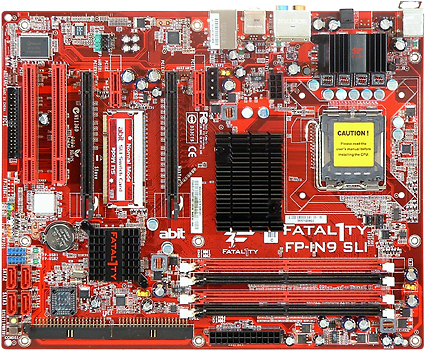Seven 650i SLI Motherboards Compared
Abit Fatal1ty FP-IN9 SLI: Sports Economy
Like previous boards in its Fatal1ty series, Abit's FP-IN9 focuses only on features that the company feels are essential or otherwise helpful in gaming. Gone are redundant connectors and controllers, and even the rarely-needed floppy header is pushed to an obscure location, all in the name of design efficiency first, followed closely by economy.
Features Overview
Abit Fatal1ty FP-IN9 SLI focuses on a clean, efficient design that retains all of the commonly used features most frequently demanded by middle-market buyers on a Rally Red printed circuit board. Based on the standard 650i components, the only concession Abit makes to non-gamers is the presence of a couple extra expansion card slots.
But this inexpensive board is far from cheap, providing a middle-of-the road four-phase voltage regulator, power and reset buttons near the front bottom corner for easy bench testing and unsurprisingly, a traditional socketed BIOS IC. If none of these "features" sound exciting, take a look at the competition.
The FP-IN9 supports six expansion slots, with the seventh "empty" position located just below the top graphics card. This arrangement allows optimal access to the remaining slots when oversized graphics coolers are used, and once again places Abit's design in the lead over its largest rival.
Chipset cooling comes by way of passive sinks, which require a downdraft CPU cooler to function properly. Users of cross-draft coolers will likely need to add a fan over the Northbridge because of the 650i's high heat output. The cooler's fins are placed too closely together for adequate convective cooling.
Power connectors are placed in a compromise between what works best for traditional cases and those with the power supply at the bottom. Located just above the center point of the FP-IN9's front edge, the 24-pin ATX power connector will require a medium length cable for either case style, but this fat power cable must cross the paths of several drive bays for most case designs. Similarly, the eight-pin ATX12V power connector is found just below the CPU cooler, a location that allows medium-length cables to reach around the CPU cooler for traditional cases or around card edges in the new, less-efficient case designs.
Front Panel Audio connectors are an easier compromise, with the audio connector near the center of the FP-IN9's rear edge and the USB connectors in a clean spot along the board's lower edge. These should be an easy reach for both upper and lower front panel bays. The short distance between the audio codec and its front panel connector may have the added benefit of reducing noise.
Abit may have gone a little too far in its attempts to optimize circuit layout for best functionality, moving both ATA133 connectors to the lower half of the board and thereby forcing many buyers to stretch these wide cables a greater distance to the upper bays of their cases. A closer look at the DIMM positions shows that there was simply no room to place them on the upper portion of the board, as these have been moved around half an inch towards the front edge compared to typical designs. At least the forward-facing connectors are able to fit the cables underneath the ends of long graphics cards.
A greater challenge will face floppy users, even those who only use the ridiculously outdated format to load RAID drivers, as the connector is located under the bottom PCI slot and towards the back of the case. The result for said users will be a cable management nightmare, but in Abit's defense few builders include a floppy drive.
| Abit FP-IN9 SLI (Revision 1.10) | |
|---|---|
| Northbridge | NVIDIA nForce 650i SLI (C55 SPP) |
| Southbridge | nF430 (MCP51) |
| Voltage Regulator | Four Phases |
| BIOS | 12 (4/2/2007) |
| 266.7 MHz (FSB1066) | 266.7 MHz (+0.0%) |
| Connectors and Interfaces | |
| Onboard | 2x PCIe x16 (1x x16 or 2x x8 pathways)2x PCIe x12x PCI2x USB 2.0 (2 ports per connector)1x Floppy2x Ultra ATA4x Serial ATA 3.0Gb/s1x Front Panel Audio1x CD Audio In1x Fan 4 pins (CPU)3x Fan 3 pins (System)1x Internal Power Switch1x Internal Reset Switch |
| IO panel | 2x PS2 (keyboard + mouse)1x RJ-45 Network4x USB 2.01x Digital Audio Out (S/P-DIF optical)6x Analog Audio (7.1 Channel + Mic-In + Line-In) |
| Mass Storage Controllers | |
| MCP51 | 4x SATA 3.0Gb/s (RAID 0,1,5,10 capable)2x Ultra ATA-133 (4-drives) |
| Network | |
| NVIDIA Gigabit Network | 1x Marvell 88E1116 PHY |
| Audio | |
| HDA (Azalia) Controller Interface | Realtek ALC888 7.1 Codec |
The Fatal1ty FP-IN9 SLI takes another stab at beating its largest competitor by including Realtek's mid-spec ALC888 audio codec, rather than the entry-level ALC883.
The rear panel loses legacy Parallel and Serial ports while retaining PS/2 keyboard and mouse ports. Six analog audio jacks provide the full 7.1-channel sound output while keeping useable rear-panel Microphone and Line-Level inputs, while the optical Digital Audio output can instead feed digital amplifiers. Four USB ports and a single RJ-45 network connection fill the remaining panel portion.
Not all the empty space is by design, however. Abit left room for a second digital audio connector (coaxial) and an IEEE-1394 FireWire output, but the FireWire controller isn't found on the version we received.
Current page: Abit Fatal1ty FP-IN9 SLI: Sports Economy
Prev Page Introduction Next Page BIOS And OverclockingGet Tom's Hardware's best news and in-depth reviews, straight to your inbox.


